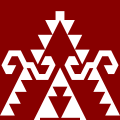Elibelinde
Appearance
Elibelinde (Turkish for "hands on hips") is a Turkish motif of a hands-on-hips female figure. It is widely used on kilims (flat tapestry-woven carpets) and occurs in many variations.[1][2][3] The arms of the figure are represented by two inward-facing hooks, while the body of the woman is represented by a triangle or diamond. The head is typically represented by a diamond. The Elibelinde is a symbol of fertility and motherhood. It is one of many kilim motifs commonly woven into Turkish flatweave rugs.[4][3]
References
[edit]- ^ "Hands on Hips - Elibelinde". Retrieved 24 February 2014.
- ^ "elibelinde". Art and Architecture Thesaurus. The J. Paul Getty Trust. Retrieved 24 February 2014.
- ^ a b Erbek, Güran (1998). Kilim Catalogue No. 1. May Selçuk A. S. Edition=1st.
- ^ Peter Davies (2000). Antique Kilims of Anatolia. W.W. Norton. p. 55. ISBN 978-0-393-73047-0.





